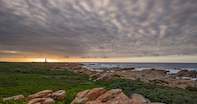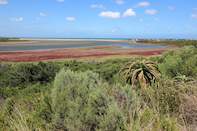South Africa has an extremely diverse plant and animal life. In order to be able to grasp and analyse this richness, scientists have classified the different kinds of vegetation across the country.

The south Western Cape region is classified as the Cape Floral Kingdom. It stretches from Port Elizabeth to Cape Town and inland, covering about 90 000 km ².
This region is recognized as being especially rich in plant species and is identified as one of only six Plant or Floral Kingdoms in the world. The region is the habitat for 9000 plant species, of which 70% are unique to South Africa and this region, in other words they grow nowhere else in the world!
The 9000 plant species are not distributed randomly however, but rather in different areas, where different kinds of plants grow together, almost like plant communities. This means that the whole region can be divided into specific vegetation types, comprising plant species that grow in their particular area and nowhere else.
St Francis Fynbos

The vegetation type that is located within the St Francis region, is St Francis Fynbos/Thicket Mosaic. This type of vegetation only grows on the lime-rich coastal sandy sites and is spread between the eastern Tsitsikamma in the west and Port Elizabeth (Cape Recife) in the east.
Land that has suitable conditions for this type of vegetation stretches across a small portion of about 25 924 hectare, which makes up only 0.2% of the Cape Floral Kingdom.
Since the time of Europeans settling in the area, disturbances and damages were caused through developments like urbanization, agriculture, forestry and alien plant invasions. Consequently, these impacts from the past, as well as future threats of continued destruction by alien plants and the expansion of coastal towns and resorts, have scientifically proven to place this vegetation under threat. It has therefore been classified as ‘Critically Endangered’ and this status means that it needs protection under national legislation.
Preservation of the St Francis Fynbos/Thicket Mosaic has been identified by scientists as a national priority for conservation, because of its inherent richness, its relatively small coverage and the degree to which it has already been destroyed, along with the future threats it faces. “It is our duty and cultural obligation to safeguard it”.
Visit the nature reserves in Cape St Francis in order to find out more about this vegetation, to view this unique plant species and to support its protection.
For more info contact FOSTER – Friends of St Francis Nature Areas